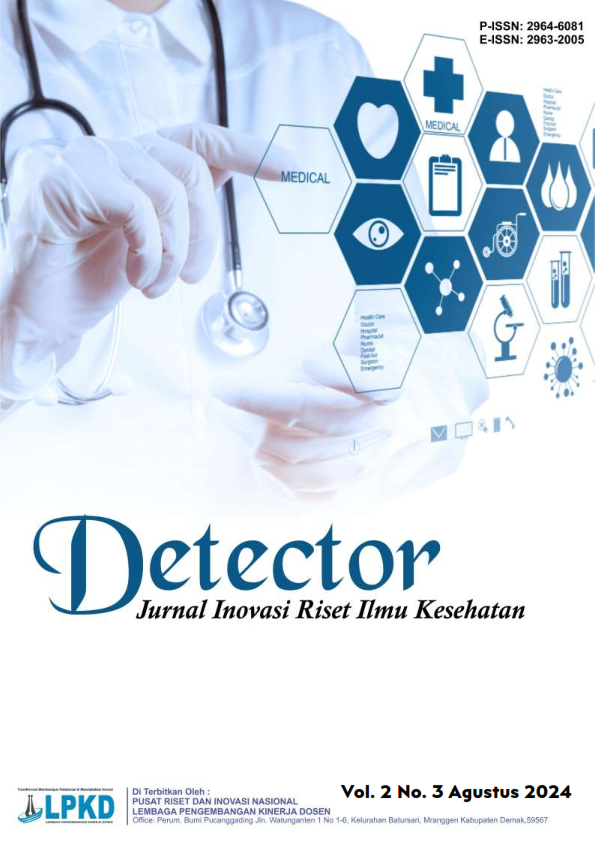Analisis Faktor Internal dan Faktor Eksternal Kepatuhan Keselamatan dan Kesehatan Kerja (K3) pada Pekerja Unit Teknik di PT X Kabupaten Magetan
DOI:
https://doi.org/10.55606/detector.v2i3.4147Keywords:
OHS, compliance, age, tenure, knowledge, attitude, motivation, ability, work environmentAbstract
Engineering units are complex activities with diverse jobs such as maintanace, machine operation and machine supervision. These jobs have a high risk of occupational accidents, so they must comply with Occupational Health and Safety (OHS) to reduce the risk of accidents and improve worker welfare. Occupational Health and Safety (OHS) Compliance can be influenced by internal factors and external factors. The purpose of this study was to identify and analyze the factors that cause Occupational Safety and Health (OHS) compliance. This research method uses quantitative research with a cross sectional research design with logistic regression analysis. Based on the output of statistical tests, the significance results of internal factors of age 0.015 <0.05, tenure 0.009 <0.05, knowledge 0.006 <0.05, attitude 0.016 <0.05, motivation 0.028 <0.05, ability 0.003 <0.05 and the significance results of external factors of work environment 0.12 <0.05. Internal factors (age, tenure, knowledge, attitude, motivation, ability) and external factors (work environment) influence and have a positive relationship with Occupational Health and Safety (OHS) compliance.
Downloads
References
Ajzen, I. (2005). Attitudes, personality and behavior. Open University Press.
Asriningrum, S. (2018). Faktor-faktor yang memengaruhi perilaku perawat dalam pemilahan limbah medis di RS Al Islam Bandung: Factors influencing nurses behavior in sorting medical waste at Al Islam Hospital. Jurnal Teras Kesehatan, 1(1), 39-54.
Astiningsih, H., Kurniawan, B., & Suroto. (2018). Hubungan penerapan program K3 terhadap kepatuhan penggunaan APD pada pekerja konstruksi di pembangunan gedung parkir Bandara Ahmad Yani Semarang. Jurnal Kesehatan Masyarakat, 6(4), 300-308.
BPJS Ketenagakerjaan. (2021). BPJS Ketenagakerjaan.
Cooper, D. (2000). Towards a model of safety culture. Applied Behavioural Science, 36, 111–136.
Imandiya, K., Zulkarnain, M., & Noviadi, P. (2024). Persepsi pekerja dalam budaya keselamatan dan kesehatan kerja: Studi kasus di industri berisiko tinggi: Literature review. Media Publikasi Promosi Kesehatan Indonesia (MPPKI), 7(1), 65-72.
International Labour Organization (ILO). (2019). Safety and health at the heart of the future of work: Building on 100 years of experience.
Irzal. (2016). Dasar-dasar kesehatan dan keselamatan kerja. Kencana.
Neal, A., & Griffin, M. (2002). Safety climate and safety behavior. Australian Journal of Management.
Saleem, F., & Malik, M. I. (2022). Safety management and safety performance nexus: Role of safety consciousness, safety climate, and responsible leadership. International Journal of Environmental Research and Public Health, 19(20), 13686.
Yusri. (2011). Improving our safety culture. PT Gramedia Pustaka Indonesia.
Downloads
Published
How to Cite
Issue
Section
License
Copyright (c) 2024 Detector: Jurnal Inovasi Riset Ilmu Kesehatan

This work is licensed under a Creative Commons Attribution-ShareAlike 4.0 International License.








